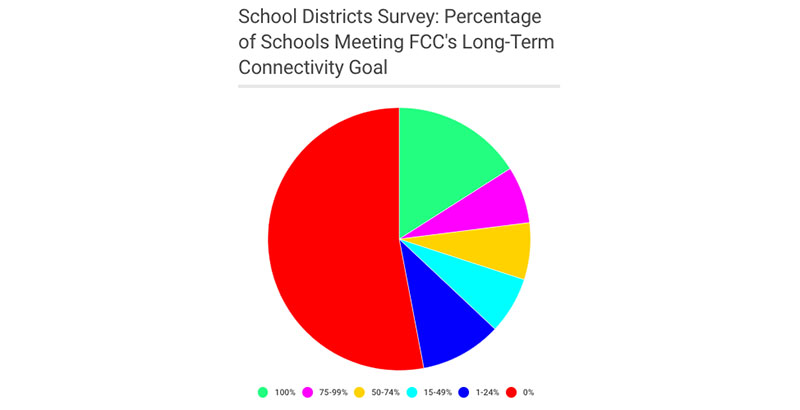First, the FCC Targeted ‘Net Neutrality.’ Could the E-rate Program, and Subsidized School Internet, Be Next?

About 85 percent of school districts meet basic internet connectivity goals set by the Federal Communications Commission that allow them to use tools like Khan Academy and Google Classroom in all of their schools, a new study finds.
The Consortium for School Networking study comes as educators are urging the FCC to continue funding E-rate, the federal program that provides subsidies and discounts for school internet infrastructure and service. Earlier this month, almost 200 school and district leaders, and more than 50 education organizations, sent letters asking the FCC to continue its annual $1 billion spending on Wi-Fi and internet infrastructure, known as Category Two spending.
Both letters argue that funding for E-rate should continue beyond 2019, the date set by a 2014 FCC order.
The FCC has embarked on a series of bold moves that could upend long-standing internet policy. Just last week, FCC Chairman Ajit Pai took aim at net neutrality, issuing a plan to dismantle regulations that ensure equal access to the internet. The plan would allow internet service companies to charge users more for some content and curtail access to some websites.
The Trump administration has yet to stake out a position on the E-rate program, and the letters the FCC solicited are the first sign it may seek a change. This has stoked fears among some educators that the FCC may roll back the program at a moment it has started to yield important dividends.
“Category Two services that support high-speed internet access, including access to reliable Wi-Fi, are vital for providing all students with a quality education to prepare them for today’s modern economy,” the letter from district leaders said.
Even though many schools have significantly updated their internet infrastructure since the 2014 FCC action, connectivity gaps remain, according to the study, published by the Consortium for School Networking, an association of school technology leaders. Four percent of districts surveyed still have no schools that meet the FCC’s short-term goal, and about 11 percent have some schools that are not connected to the internet at all, according to the study, which surveyed 445 districts across the country this fall.
“Overall, much work and continued commitment are necessary to connect students to high-capacity broadband, particularly in the hardest-to-reach communities,” Keith Krueger, CEO of the Consortium for School Networking, told The 74 by email. “The FCC, as well as our local, state and national leaders, must keep their foot on the gas.”
Schools with high percentages of students eligible for free and reduced lunch, a typical marker of poverty, tend to lack service at higher rates than those at more affluent schools, John Harrington, CEO of Funds for Learning, told The 74. The report supports a study released earlier this year by Education SuperHighway, a nonprofit organization that supports better internet access in classrooms, showing that schools in 45 states lack sufficient internet service.
When it updated the E-rate program in 2014, the FCC set both long- and short-term goals. The short-term goal is reaching 100 megabits (Mbps) per second, the bandwidth threshold that allows for basic Web-based classroom activities such as watching Khan Academy videos. The Consortium study found that only 16 percent of districts surveyed met the FCC’s long-term goal of 1 gigabit (Gbps) per second per 1,000 students in all of their schools, which allows for what experts call a “media-rich” environment in every classroom.
Data: Consortium for School Networking
With that additional bandwidth, much more is possible in digital learning, such as a virtual reality museum or laboratory tour, Harrington said.
“I don’t think we’ve been able to really understand that potential because it’s really not been there yet,” Harrington told The 74. “Once that bandwidth is there and once you’ve got hundreds of thousands of teachers and millions of students [who] are playing with and exploring it — man, they’re going to uncover uses and things that probably none of us have really guessed yet. But it takes getting that bandwidth there to even unlock those opportunities.”
Since 2014, school and library connectivity rates have soared. However, cost remains the most frequently cited barrier to schools connecting or increasing their bandwidth, the survey found.

FCC Chairman Pai has said he wants to simplify E-rate applications and has criticized parts of the program, but his intentions for future funding are unclear. The ambiguity has stoked fears that without continued funding, schools may lose ground in their pursuit of expanded connectivity.
“We welcomed the chairman’s interest in simplifying the application process, but we remain deeply concerned the FCC is considering early changes to the program’s Category Two investments,” said Krueger. “Many school districts are counting on the five-year budget cycle that was considered under the FCC’s 2014 modernization of the program. However, the Commission’s recent Category Two inquiry indicates a desired change might be on the horizon.”
Help fund stories like this. Donate now!

;)
